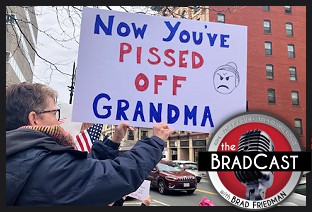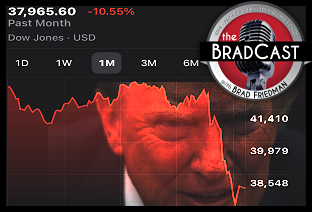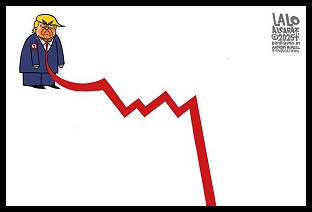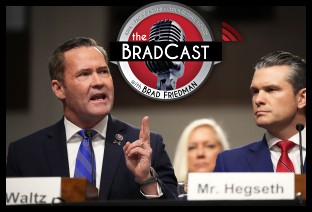 As the ingenious GOP on GOP rebellion continues in the U.S. House today, we cover that and some clarifying new insights from the 2022 elections regarding the "red wave" that never came (as we long told you it wouldn't) on today's BradCast. [Audio link to full show follows this summary.]
As the ingenious GOP on GOP rebellion continues in the U.S. House today, we cover that and some clarifying new insights from the 2022 elections regarding the "red wave" that never came (as we long told you it wouldn't) on today's BradCast. [Audio link to full show follows this summary.]
Day 2 of the GOP Rebellion Without Any Actual Cause That I Know Of continued on Wednesday, with Republicans failing on Ballots 4, 5 and 6 to secure a majority of votes of those present and voting for any candidate for House Speaker. The Democratic nominee on every ballot, their new leader Hakeem Jeffries, continued to be the top vote-getter in every round, receiving a unified 212 votes on each ballot.
On the GOP side, their leader Kevin McCarthy received just 201 votes on each of Wednesday's three ballots, down one vote from the third vote yesterday and still well shy of the 218 votes needed for a majority. The new trick today from the Republican "rebels" was nominating African-American second-term back-bencher Byron Donalds of Florida to be Speaker even though (or, perhaps, because?) he pleaded guilty to felony bribery charges back in 2000 in a scheme to defraud a bank. A bit on-brand for today's GOP but otherwise perfect for the job!
There were a few tiny nuances and the slightest movement (away from McCarthy and toward the Gaetz/Boehbert-led rebel group of 20) in the afternoon's three rounds of voting. We'll see what, if anything, happens when they reconvene for an evening session at 8pm ET on Wednesday night. (They just reconvened. The GOP moved to adjourn until Thursday at noon, and won that chaotic vote by the barest of margins.)
But, hey, so far, for two days in a row, the GOP House has been unable to do any legislative damage to the country!
Next, it's on to our guest today, the great TOM BONIER, master Tweeter and CEO of the Democratic data research firm, TargetSmart. Bonier joined us on the program a number of times since late last summer, in the run-up to the 2022 elections and in the days that followed. He was one of very few publicly on record (along with Simon Rosenberg of New Democrat Network) who presented hard data that correctly countered the false "red wave" narrative promulgated in the months before last year's November midterms.
Over the weekend, the New York Times ran a 4,000-word analysis headlined "The 'Red Wave' Washout: How Skewed Polls Fed a False Election Narrative". It explores no small amount of what we'd been trying to tell you since early last spring. Namely, that Democrats were likely to do much better than both history and professional pundits were telling you, and that, as Bonier and Rosenberg detailed in the face of mockery by some last year, the polls late in the season were actually misleading voters.
Specifically, as the paper reports, beginning in September last year, a bevy of partisan Republican polls with dodgy methodology were released, almost all suggesting the GOP was on the verge of not only a "red wave" election but a "red tsunami". The partisan numbers, cited with great excitement by rightwing media outlets initially and then by non-rightwing media, seemed to conflict with polls from most legitimate, nonpartisan polling outfits. But the public release of a ton of partisan polling served to game the polling averages at highly-trafficked forecast sites like 538 and RealClearPolitics. More disturbingly, the skewed numbers resulted in Democratic campaigns changing strategies and spending in hopes of shoring up otherwise safe seats, while abandoning races --- such as U.S. Senate contests in Wisconsin, Ohio and North Carolina and a bunch of House districts around the country --- that were almost certainly otherwise winnable.
Why did this happen? Was it a concerted strategy by Republicans to game the public polling averages? And, if so, why did the supposed polling gatekeepers --- like Nate Silver at 538, who dismissed and mocked folks like Bonier and Rosenberg for relying on "hopium" in their accurate data analysis --- fail to protect against the partisan manipulation? Also, while the Times analysis suggests otherwise, did those false numbers actually serve to goose Dem turnout in some races last year?
In short, when I ask Bonier directly today if Republicans figured out last year how to game the polling averages, he responds, "Yes. Simply, yes. That's what happened. And it couldn't have happened without others playing along with it and empowering it."
"In the end, they were successful," he tells me. "Were they successful to the point where they were able to create a red wave? No. But they were successful to the point where Republicans won some races that I don't think they would have without this happening."
So, what to do about it moving forward? We dig into details on that and much more with Bonier today, and also get his insight into whatever the hell is going on in the Republicans' dumpster fire failure to select a House Speaker to begin the 118th U.S. Congress after two days (and counting) of trying...
(Snail mail support to "Brad Friedman, 7095 Hollywood Blvd., #594 Los Angeles, CA 90028" always welcome too!)
|


 Sunday 'Zero Day' Toons
Sunday 'Zero Day' Toons Soc. Sec. Expert Warns DOGE Hastening Collapse, Privati-zation: 'BradCast' 4/10/2025
Soc. Sec. Expert Warns DOGE Hastening Collapse, Privati-zation: 'BradCast' 4/10/2025 'Green News Report' 4/10/25
'Green News Report' 4/10/25
 Trump Blinks, Chaos Reigns, Markets Spike as Many Tariffs Remain Despite 90-Day 'Pause': 'BradCast' 4/9/25
Trump Blinks, Chaos Reigns, Markets Spike as Many Tariffs Remain Despite 90-Day 'Pause': 'BradCast' 4/9/25 SCOTUS Deportation Ruling Grimmer Than First Appears: 'BradCast' 4/8/25
SCOTUS Deportation Ruling Grimmer Than First Appears: 'BradCast' 4/8/25 'Green News Report' 4/8/25
'Green News Report' 4/8/25 Cliff Diving with Donald: 'BradCast' 4/7/25
Cliff Diving with Donald: 'BradCast' 4/7/25 Sunday 'Don't Look Down' Toons
Sunday 'Don't Look Down' Toons 'Green News Report' 4/3/25
'Green News Report' 4/3/25 'Mob Boss' Trump's Trade Sanctions Tank U.S., World Markets: 'BradCast' 4/3/25
'Mob Boss' Trump's Trade Sanctions Tank U.S., World Markets: 'BradCast' 4/3/25 Crawford Landslide in WI; Booker Makes History in U.S. Senate: 'BradCast' 4/2/25
Crawford Landslide in WI; Booker Makes History in U.S. Senate: 'BradCast' 4/2/25 Judge Ends Challenge to GA's Unverifiable, Insecure Vote System: 'BradCast' 4/1/25
Judge Ends Challenge to GA's Unverifiable, Insecure Vote System: 'BradCast' 4/1/25 Bad Court, Election News for Trump is Good News for U.S.: 'BradCast' 3/31
Bad Court, Election News for Trump is Good News for U.S.: 'BradCast' 3/31 Vets Push Back at Plan to Slash Health Care, 80K V.A. Jobs: 'BradCast' 3/27/25
Vets Push Back at Plan to Slash Health Care, 80K V.A. Jobs: 'BradCast' 3/27/25 Signal Scandal Worsens for Trump, GOP; Big Dem Election Wins in PA: 'BradCast' 3/26
Signal Scandal Worsens for Trump, GOP; Big Dem Election Wins in PA: 'BradCast' 3/26 'Emptywheel': Trump NatSec Team Should 'Resign in Disgrace': 'BradCast' 3/25/25
'Emptywheel': Trump NatSec Team Should 'Resign in Disgrace': 'BradCast' 3/25/25 USPS 'Belongs to the People, Not the Billionaires': 'BradCast' 3/24/25
USPS 'Belongs to the People, Not the Billionaires': 'BradCast' 3/24/25
 VA GOP VOTER REG FRAUDSTER OFF HOOK
VA GOP VOTER REG FRAUDSTER OFF HOOK Criminal GOP Voter Registration Fraud Probe Expanding in VA
Criminal GOP Voter Registration Fraud Probe Expanding in VA DOJ PROBE SOUGHT AFTER VA ARREST
DOJ PROBE SOUGHT AFTER VA ARREST Arrest in VA: GOP Voter Reg Scandal Widens
Arrest in VA: GOP Voter Reg Scandal Widens ALL TOGETHER: ROVE, SPROUL, KOCHS, RNC
ALL TOGETHER: ROVE, SPROUL, KOCHS, RNC LATimes: RNC's 'Fired' Sproul Working for Repubs in 'as Many as 30 States'
LATimes: RNC's 'Fired' Sproul Working for Repubs in 'as Many as 30 States' 'Fired' Sproul Group 'Cloned', Still Working for Republicans in At Least 10 States
'Fired' Sproul Group 'Cloned', Still Working for Republicans in At Least 10 States FINALLY: FOX ON GOP REG FRAUD SCANDAL
FINALLY: FOX ON GOP REG FRAUD SCANDAL COLORADO FOLLOWS FLORIDA WITH GOP CRIMINAL INVESTIGATION
COLORADO FOLLOWS FLORIDA WITH GOP CRIMINAL INVESTIGATION CRIMINAL PROBE LAUNCHED INTO GOP VOTER REGISTRATION FRAUD SCANDAL IN FL
CRIMINAL PROBE LAUNCHED INTO GOP VOTER REGISTRATION FRAUD SCANDAL IN FL Brad Breaks PA Photo ID & GOP Registration Fraud Scandal News on Hartmann TV
Brad Breaks PA Photo ID & GOP Registration Fraud Scandal News on Hartmann TV  CAUGHT ON TAPE: COORDINATED NATIONWIDE GOP VOTER REG SCAM
CAUGHT ON TAPE: COORDINATED NATIONWIDE GOP VOTER REG SCAM CRIMINAL ELECTION FRAUD COMPLAINT FILED AGAINST GOP 'FRAUD' FIRM
CRIMINAL ELECTION FRAUD COMPLAINT FILED AGAINST GOP 'FRAUD' FIRM RICK SCOTT GETS ROLLED IN GOP REGISTRATION FRAUD SCANDAL
RICK SCOTT GETS ROLLED IN GOP REGISTRATION FRAUD SCANDAL VIDEO: Brad Breaks GOP Reg Fraud Scandal on Hartmann TV
VIDEO: Brad Breaks GOP Reg Fraud Scandal on Hartmann TV RNC FIRES NATIONAL VOTER REGISTRATION FIRM FOR FRAUD
RNC FIRES NATIONAL VOTER REGISTRATION FIRM FOR FRAUD EXCLUSIVE: Intvw w/ FL Official Who First Discovered GOP Reg Fraud
EXCLUSIVE: Intvw w/ FL Official Who First Discovered GOP Reg Fraud GOP REGISTRATION FRAUD FOUND IN FL
GOP REGISTRATION FRAUD FOUND IN FL



















 Well, we're back on today's
Well, we're back on today's  The violence was no accident. It was not a peaceful protest that spun out of control. Instead, as Rep. Elizabeth Cheney (R-WY)
The violence was no accident. It was not a peaceful protest that spun out of control. Instead, as Rep. Elizabeth Cheney (R-WY) 

 Before our Holiday Hiatus, we wrap up the year on today's
Before our Holiday Hiatus, we wrap up the year on today's 







 Well, Merry Christmas from The U.S. House and
Well, Merry Christmas from The U.S. House and 
 While Special Counsel Jack Smith is said to be investigating the Trump-incited January 6 insurrection at the U.S. Capitol and the his fake electors plot to try and steal the 2020 election, among other things, there is a still-ongoing, post-2020, multi-state plot, coordinated by Trump's top MAGA lieutenants that the Feds don't yet seem to be probing. Our guest on today's
While Special Counsel Jack Smith is said to be investigating the Trump-incited January 6 insurrection at the U.S. Capitol and the his fake electors plot to try and steal the 2020 election, among other things, there is a still-ongoing, post-2020, multi-state plot, coordinated by Trump's top MAGA lieutenants that the Feds don't yet seem to be probing. Our guest on today's 
 So, I've sorta been trying to avoid coverage on
So, I've sorta been trying to avoid coverage on  Nope. The 2022 midterms still aren't fully over. At least not on
Nope. The 2022 midterms still aren't fully over. At least not on 














